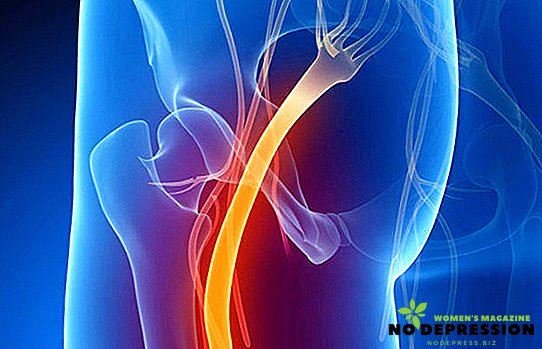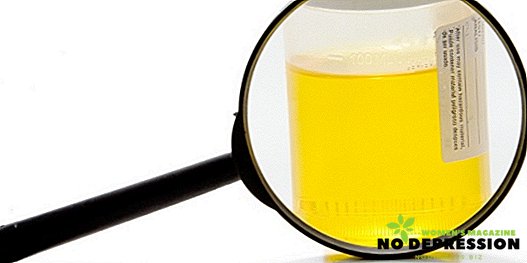Inflammation of the sciatic nerve (sciatica) is a pathological process that can be accompanied by severe pain. Over time, in the absence of proper treatment, stronger symptoms appear, for example, a person loses the ability to move his fingers, his foot. This disease requires long-term treatment with medication, massage and physiotherapy.

The main causes of inflammation
The most well-known reason leading to such a problem is the pathological processes that occur in the lumbar region or the sacrum. By pinching the nerve can lead to:
- presence of bone growths;
- disc offset;
- intervertebral hernia;
- consequences of infectious diseases;
- strong physical exertion;
- bruises and spinal injuries;
- tumor.
 For example, if we speak about the hernial protrusion of the intervertebral disc, then in this case the elements of the spinal cord are trapped, which leads to inflammation of the sciatic nerve.
For example, if we speak about the hernial protrusion of the intervertebral disc, then in this case the elements of the spinal cord are trapped, which leads to inflammation of the sciatic nerve.
Arthrosis can also lead to the appearance of sciatica, which manifests itself in the formation of growths on the vertebrae - as a result, they put pressure on the nerve fibers, causing their inflammation.
In addition, toxicity can lead to inflammation: alcohol, heavy metals, and other toxic compounds.
Often, this problem is caused by toxins that are released by pathogenic bacteria: most often, sciatica appears after an acute infection, flu.
What are the symptoms
The main symptom is pain, the intensity of which depends on the cause. Most often it is localized along the nerve, because of which the painful sensations manifest themselves in the area of the buttocks, thighs, and tibia. In this case, the sensations are usually intense, "shooting."
But also the pain can be both constant and episodic, with the passage of time the sensations intensify, exhausting the person. Moreover, any action, effort, even a banal cough can cause increased pain.
 In addition to pain, the sensitivity of the muscles decreases, the thermoregulation (cooling of the arms and legs) is disturbed, and there is a feeling of "goosebumps" all over the body.
In addition to pain, the sensitivity of the muscles decreases, the thermoregulation (cooling of the arms and legs) is disturbed, and there is a feeling of "goosebumps" all over the body.
During the examination, the physician will without fail pay attention to the nature of the pain, as this allows you to make the correct diagnosis and determine the location of the inflamed area.
So, there are a number of some specific signs indicating the presence of sciatica:
- a symptom of planting when a person cannot sit on their own;
- Lasegue symptom - it is impossible to raise the leg in a straight state;
- Sicard symptom - pain occurs when the foot flexes.
There are also the following symptoms:
Problems with the sensitivity of the limbs
At an early stage, this symptom leads to numbness or a tingling sensation. Over time, with no treatment, the sensitivity disappears.
Motor impairment
Due to the prolonged infringement of the nerve, the limbs constantly experience muscle weakness. This leads to a change in gait - a person limping over a sore limb.
Pelvic dysfunction
Manifested in the form of burning and pain during urination, urinary incontinence as a result of the lack of treatment for a pinched nerve.
Bouts of inflammation
Most often, attacks occur at night, and they can be caused by existing chronic diseases, as well as simple hypothermia or even stress.
The pain increases with prolonged walking, when sitting on an uncomfortable or very hard surface. Moreover, during attacks, the painful sensations are so strong and sharp that they force a person to take a certain posture, relying on a healthy leg. At the same time, other manifestations of inflammation may appear: swelling, sweating, redness. If inflammation is associated with an infection in the body, a fever or weakness may be observed.

In severe cases, the “work” of the nerve can be completely disturbed, the muscles (buttocks, thighs) are reduced, the person cannot move, for example, bend her fingers. This must be reported to the doctor, since the symptoms and further treatment are closely interrelated.
How is the diagnosis
In order for the doctor to determine the most effective method of fighting inflammation, you must first determine the cause. Diagnosis of sciatica should be carried out by a neurologist, prescribing laboratory tests.
The most affordable way is x-ray, which will allow you to see bone growths or other changes in the lumbosacral region.
And you need to take two pictures - the second is needed to find out if the pinching is not connected with the pathology of the intervertebral discs.
If this method was not enough, the patient may be referred to a CT scan or MRI - these methods are considered the most informative, since they allow you to immediately find out the cause of the inflammation (but only if the pinch is not caused by changes in the vessels or spinal cord).
If the doctor has a suspicion of a tumor, he is sent to scan the spine.
Treatment of sciatic nerve inflammation
Combined therapy in the treatment of this disease is aimed at relieving pain, restoring motor functions, and sensitivity. To do this, use drugs, massage, physiotherapy, physical therapy. Found and widely used alternative medicine techniques, such as acupuncture, folk remedies.
Preparations
 Let's take a closer look at which drugs should be used for sciatic nerve inflammation. These include drugs of the NSAID group, such as Diclofenac and Ketoprofen. In some cases, non-narcotic analgesics may be prescribed, which include Pentalgin and Sedalgin.
Let's take a closer look at which drugs should be used for sciatic nerve inflammation. These include drugs of the NSAID group, such as Diclofenac and Ketoprofen. In some cases, non-narcotic analgesics may be prescribed, which include Pentalgin and Sedalgin.
If the patient is tormented by very strong pains, and at the same time they cannot be stopped by the listed drugs, opioid analgesics can be prescribed, for example, Tramadol. Remember that they need to be taken strictly under the supervision of a physician and in small courses so that addiction does not arise and side effects do not appear.
In the acute course of the disease, hormone preparations (Prednisolone) are prescribed, which relieve swelling, suppress the development of inflammation, improve mobility. Such drugs are prescribed extremely rarely and only when a strong edema appears in the lumbar region.
Vitamins, muscle relaxants (Sirdalud, Tolperisone) may be additionally prescribed as maintenance therapy.
Drugs that contain vitamin B, for example, Binavit, help make the symptoms of the disease less bright, restore the permeability of nerve impulses, so that you can quickly restore the sensitivity of the limbs.
To restore impaired blood circulation, special microcirculation correctors are prescribed. The most popular remedy is Trental. Such drugs help in the fight against atrophic changes in the muscles, restore damaged parts of the nerve. Additionally, vitamin complexes with a high content of copper or selenium can be prescribed - they will also help in recovery.
Ointment
Pain-relieving ointments are prescribed, and they must have a warming effect, improve blood circulation.
 When inflammation is prescribed the following types:
When inflammation is prescribed the following types:
- on the basis of poison - snake or bee (Apifor);
- on the basis of turpentine;
- with pepper extract (Espol);
- from the group of NSAIDs (Nurofen);
- warming drugs (Kapsikam).
Apply the ointment should be 2-3 times a day, and after the application is required to close the skin with a warm bandage to enhance the action of the tool.
Exercise therapy
Physiotherapy treatment is necessary during remission, when there is no pain, but other symptoms remain that are caused by an abnormal diet. Most often, patients are prescribed:
- massage;
- magnetic therapy;
- electrophoresis.
Such activities will help to relax the muscles, remove the clamp of the nerve roots, help restore limb mobility, minimize the risk of symptoms.
Operative intervention
Surgical treatment of inflammation of the sciatic nerve can be prescribed only if all of the above methods had no effect. Usually perform discectomy, that is, complete or partial removal of the intervertebral disc, which became the cause of pinching.
Folk remedies for pinching
There are many popular methods of treatment of sciatica. However, before you try them for yourself, you should get expert advice that will avoid serious complications.
Beeswax
It is necessary to make warming compresses with its use. They will help to cope with the pain. Before holding this event, melt the wax in a water bath and make a cake of this size so that it covers the affected area. Attach the resulting cake, secure with a towel and leave overnight. Repeat the procedure once a week for 7 days.
Pine buds
Based on them, you need to make a tincture - it will not only reduce the pain, but also relieve inflammation. Pour half a 0.5-liter jar of vegetable raw materials, pour 300 ml of vodka and leave for a week, putting the container in a dark place. After this, rub the affected area with tincture every day for a week.
Now you know for what reason inflammation of the sciatic nerve occurs, what treatment methods will help to cope with this problem.












